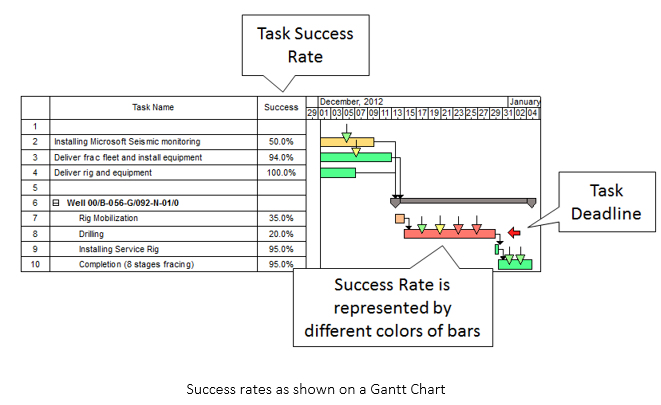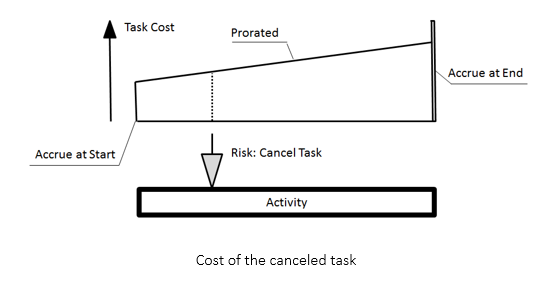Success rate is a chance that project or task is not canceled. For example, if task can be canceled for various reasons 45 times from 100. It means that task success rate equals 55%.
Tasks can be cancelled if:
- A task reaches a task deadline, if deadline leads to cancelation of the task
- A task reaches a project deadline, if deadline leads to cancelation of the task
- A risk with an impact of “Cancel task” or “Cancel task and all successors” occurs and is assigned to the task. For example, if the probability of the risk of with this impact is 10%, the success rate of the task will be 90% as long as task cannot be canceled because of other factors
- A risk with an impact “Cancel task and all successors” occurs and is assigned to one of the tasks predecessors
- Success rates can be reduced due to of branching: certain activities may not be executed because a branching condition is met. Branching will be discussed in a future post.
Projects can be canceled if the following conditions occur:
- Any tasks of the project reach a project deadline if deadline leads to cancelation of the task
- Risks with an impact type “cancel project” occur and are assigned to any task or resources.
In most cases, success rates of projects or tasks are affected by combinations of these factors. When you run a Monte Carlo simulation, any combination of factors can occur during an iteration. On some iterations, a risk impact “Cancel task” can occur, on other iterations a task or project will be reach a deadline. In addition, project or tasks can be canceled due to some “exotic” conditions; for example, cancellations due to resource overallocation or as a result of the execution of a response plan. In most cases, such conditions can be modeled using event chains where the receiver risk of these chains will be an event with impact time “Cancel task” or “Cancel Project”.
Task cancelation can cause very interesting phenomenon. Sometimes projects can be affected by many risks, but a project with risks can be shorter than a project without risks. Commonly, risks are threats and increase project duration. However, in the cases of opportunities or risks with an impact that cancels tasks, you can possibly simulation results where the base duration is less than the original estimate.
If a task is cancelled and has a fixed or variable cost, the task cost will depend on the moment of risk.
Here is a simple example. The task’s fixed cost is $5,000 and is accrued at the start. Another fixed cost is $3,000 and accrued at the end. Variable costs are prorated at $100/hour. Now let us assume that the original task duration was 10 hours, but a risk occurred, and was canceled after 6 hours. The cost after cancelation will be $5,000 + 6*$100 = $5,600. Fixed costs that accrued at the end are ignored.
Task cancelation may affect summary tasks; however, there could be different rules on how the- cancelation of summary task might occur if subtasks are cancelled. The simplest way to deal with it is to have special risk impact types: “Cancel task and all summary tasks” or “Cancel task and immediate summary task”. In this case if a risk occurs it will only impact the task and specified summary tasks.
Success rate can be shown on the Gantt chart, where different Gantt bars will have different colors. Green bars will be associated with higher success rates, yellow bar will be associated with medium success rates, and red bars will be associated with low success rates.


